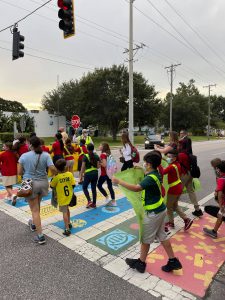
Tampa, Florida
Are you looking to make lasting change that supports walking, biking and rolling to school? Many events begin out of a desire to support daily, active travel but road safety problems get in the way. Perhaps caregivers are worried about the speed of traffic along the route between home and school, or the school principal has concerns about a street crossing for students who don’t have other options for how to get to school. Communities see Walk & Roll to School Day (formerly Walk to School Day) as an opportunity to spotlight the importance of road safety and support new programs and infrastructure.
After the 2021 Walk to School Day event, surveys and interviews were used to provide insights into local trends and stories. In the post-event survey, 65% of event organizers reported that their event led to policy or engineering changes to support daily walking and biking, the highest percentage reporting changes since 2014. The top three changes include the addition of signage that supports safe walking or biking to school; changes to drop off and pick up procedures, and the addition of sidewalks, paths or crosswalks.
Long-term changes inspired by Walk to School Day events
Speed reductions on nearby streets and lengthened school zone
Road diet that reduced the street from four lanes to two travel lanes, a turn lane, and bike lanes on both sides of the street
New crosswalks
New stop signs and traffic lights
Pedestrian bulb-outs to reduce crossing distance
Change to local ordinances to require sidewalk installation in new developments
Changes to pick up and drop off areas to improve safety for walkers and rollers
We interviewed four 2021 Walk to School Day event organizers to learn more about how their events led to long-term changes. Special thanks to the organizers who shared their time and experience: a PTA member in Richmond, Virginia; representatives from Ocean Springs Pedestrians & Residents for Exercise & Youth Safety (OSPREYS) in Mississippi; Sidewalk Stompers in Tampa, Florida; and a teacher in Scottsbluff, Nebraska. We hope you’ll find inspiration or a new idea to use in your community.
The long-term goal is physical changes to our streets, but there is a lot you can do in the short term that doesn’t require a lot of knowledge or funding. Like a walking program! It can be simple and then you can grow from there.
– Scottsbluff, NE, Walk to School Day organizer
Here’s how one Walk to School Day organizer did it:
A group of community members used several data collection methods to show a need for investment in road safety that led to a variety of design changes to create safer spaces for walking and rolling to school:
Here’s how one Walk to School Day organizer did it:
Families from a neighborhood north of a school were banned from walking and biking to school due to safety concerns with crossing a busy arterial road. The community successfully lowered speeds and implemented a road diet, adding new, safer crossings and bike lanes on a street near a school. They built support by engaging the community in two main ways:
Walk, Bike & Roll to School Day event organizers care deeply about their communities and believe in the value of more students being able to safely walk and roll to school. We hope that sharing the experience of previous Walk to School Day organizers will provide inspiration for others looking to take action for making changes to streets, slowing traffic or addressing other needs in your community.